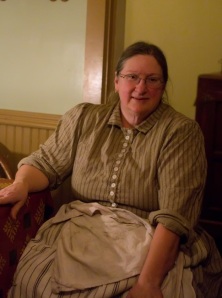Living History Is My Livelihood
Kay’s Story
When asked by someone what I do for a living it usually ends up being an educational opportunity for the person who has asked me that question. You see I am a living historian. A statement like that will usually be followed with a quizzical look or a plethora of questions wanting a deeper explanation. It is simple really. My job is to help people understand the past through interpretation. Through my work, I have met people from all over the world and have exchanged many thoughts and ideas about the past, in particular the everyday past of a small town community.
My passion for history began when I was young. I blame my parents for letting me visit antique stores at an early age, and I bought my first antique at the age of 13. I spent hours and hours riding my bicycle around Grand Island looking at all the old buildings and wondering what the story was behind them. I also spent many an hour frustrated when learning one of the old beauties was to be torn down. To me, this was like losing a family member. I explored every nook and cranny in town, not knowing how well my adventures would serve me in my present job. I hold the memory of all those lost buildings dear, and on more than one occasion directed someone to the spot where something important once stood.
I always knew I would work at the museum, and had often told people that when I  was teenager. Knowing all I can about the area’s past, haunting any antique store I could find, asking questions, immersing myself in research and having a 19th century copy of the Sears Roebuck Catalog for light reading has greatly aided me in becoming better able to translate the past for the people of the present, providing them with a comparison to their daily life that will hopefully provoke them to want to learn more about the past. As far as I am concerned, you can never know enough about the past!
was teenager. Knowing all I can about the area’s past, haunting any antique store I could find, asking questions, immersing myself in research and having a 19th century copy of the Sears Roebuck Catalog for light reading has greatly aided me in becoming better able to translate the past for the people of the present, providing them with a comparison to their daily life that will hopefully provoke them to want to learn more about the past. As far as I am concerned, you can never know enough about the past!
About Kay
For almost twenty-five years, Kay Cynova has worked at Stuhr Museum in many areas, but has spent the most time as an interpreter, and has served as the Director of Historical Interpretation since 2002. She is responsible for the interpretation in the recreated 1890s town on the museum grounds – Railroad Town, Nebr., the 1860s Log Road Ranche and other areas where interpretation is needed. She presents various programs on history relating to foodways, period clothing, underwear and material culture. She is a member of ALHFAM, MOMCC and NAI (CILH Section), and has presented sessions or workshops at conferences across the country.
*************

